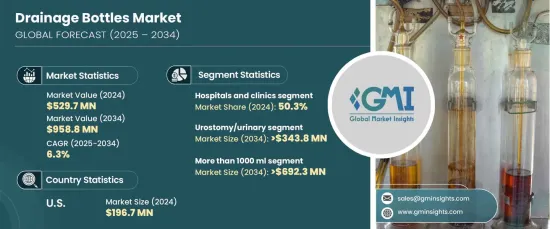
세계 배액병 시장은 2024년 5억 2,970만 달러로 평가되었으며, 2025-2034년까지 CAGR 6.3%로 안정적인 성장이 전망되고 있습니다.
이 시장 확대의 주요 요인은 만성 질환의 유병률 증가, 수술 건수 증가, 노인 증가이며, 이들 모두가 보다 효과적인 배액 솔루션을 요구하고 있습니다. 또한, 배액 기술의 발전은 효율성, 안전성 및 전체 환자 관리를 개선하고 이러한 필수 의료기기의 보급을 더욱 촉진하고 있습니다.

흉수 저류, 암, 신부전 등의 만성 질환은 배액병 수요를 크게 증가시키고 있습니다. 이러한 기구는 체액의 축적을 관리하고, 환자의 회복을 개선하고, 추가 합병증을 예방하기 위해 매우 중요합니다. 전 세계적으로 수술 건수가 계속 증가하고 있기 때문에 수술 후 위험을 최소화하고 감염을 예방하고 회복을 가속화하기 위한 배액 솔루션에 대한 요구가 높아지고 있습니다.
| 시장 범위 | |
|---|---|
| 시작 연도 | 2024년 |
| 예측 연도 | 2025-2034년 |
| 시작 금액 | 5억 2,970만 달러 |
| 예측 금액 | 9억 5,880만 달러 |
| CAGR | 6.3% |
이 시장은 흉강 배액, 비뇨기 배액, 가속 증발, 복막 배액, 기타 등 용도별로 분류됩니다. 요루/비뇨기 부문이 시장을 선도하고, CAGR 6.5%로 고성장이 예상되며, 2034년에는 추정 3억 4,380만 달러에 이를 것으로 예상됩니다. 이 성장의 원동력은 요실금, 요폐, 수술 후 배액이 필요한 상태와 같은 배뇨 장애 발생률 증가입니다. 고령화는 신장병, 전립선 비대증, 방광암의 발생률이 증가함에 따라 장기간 케어의 요구에 대응하는 배뇨 솔루션 수요를 계속 견인하고 있습니다.
용량의 경우 시장은 용량 1,000ml 이상의 병과 1,000ml 이하의 병으로 구분됩니다. 1,000ml가 넘는 대용량 병이 시장을 독점하고 있으며, CAGR 6.4%로 성장하여 2034년에는 6억 9,230만 달러에 달할 것으로 예측됩니다. 이러한 대용량 병은 특히 병원, 클리닉, 재택 간호 현장에서 대량의 수액을 관리하는 능력에서 높은 인기가 있습니다. 용량이 크므로 자주 비울 필요가 없으며 넘칠 위험도 줄어들어 환자와 의료 제공업체의 전반적인 편의성을 높일 수 있습니다.
미국 배액병 시장은 선진 의료 인프라와 매년 수행되는 대량의 수술로 지배적인 지위를 차지합니다. 이 나라에서는 의료 지출이 증가하고 있으며 수술 후 합병증의 감소에 중점을 두고 있기 때문에 첨단 배액 솔루션의 채용이 진행되고 있습니다. 또한 휴대용 배액병과 가정용 배액병의 혁신이 인기를 끌고 있습니다. 이러한 진보는 환자가 임상 장소 이외에도 효과적으로 배액를 관리할 수 있게 하여 조기 회복과 전반적인 자립을 촉진합니다.
The Global Drainage Bottles Market was valued at USD 529.7 million in 2024 and is expected to experience a steady growth rate of 6.3% CAGR from 2025 to 2034. This expansion is primarily driven by the rising prevalence of chronic diseases, the increasing number of surgeries, and the growing elderly population, all of which demand more effective fluid drainage solutions. In addition, advancements in drainage technology are improving the efficiency, safety, and overall patient care, further fueling the widespread adoption of these essential medical devices.

Chronic conditions such as pleural effusion, cancer, and kidney failure are significantly increasing the demand for drainage bottles. These devices are crucial for managing fluid buildup, improving patient recovery, and preventing further complications. As the number of surgeries continues to rise worldwide, there is a heightened need for drainage solutions to minimize post-operative risks, prevent infections, and accelerate recovery.
| Market Scope | |
|---|---|
| Start Year | 2024 |
| Forecast Year | 2025-2034 |
| Start Value | $529.7 Million |
| Forecast Value | $ 958.8 Million |
| CAGR | 6.3% |
The market is categorized by application, including chest drainage, urostomy/urinary, accel evacuated, peritoneal drainage, and others. The urostomy/urinary segment is expected to lead the market, growing at a strong 6.5% CAGR and reaching an estimated USD 343.8 million by 2034. This growth is driven by the increasing incidence of urinary disorders such as incontinence, retention, and conditions that require post-surgical drainage. The aging population, coupled with the rising rates of kidney diseases, benign prostatic hyperplasia, and bladder cancer, continues to drive demand for drainage solutions that cater to long-term care needs.
Regarding capacity, the market is segmented into bottles with capacities above 1000 ml and below 1000 ml. The larger-capacity bottles, those exceeding 1000 ml, dominate the market and are projected to grow at a CAGR of 6.4%, reaching USD 692.3 million by 2034. These larger bottles are highly sought after for their ability to manage significant fluid volumes, particularly in hospitals, clinics, and home care settings. Their larger capacity reduces the need for frequent emptying, decreases the risk of overflow, and improves overall convenience for patients and healthcare providers alike.
The U.S. drainage bottles market holds a dominant position due to its advanced healthcare infrastructure and the high volume of surgical procedures performed each year. The country's increasing healthcare expenditures, combined with a strong focus on reducing post-operative complications, have driven the adoption of advanced drainage solutions. Furthermore, innovations in portable and home-use drainage bottles are gaining popularity. These advancements allow patients to manage fluid drainage effectively outside of clinical settings, promoting quicker recoveries and greater overall independence.